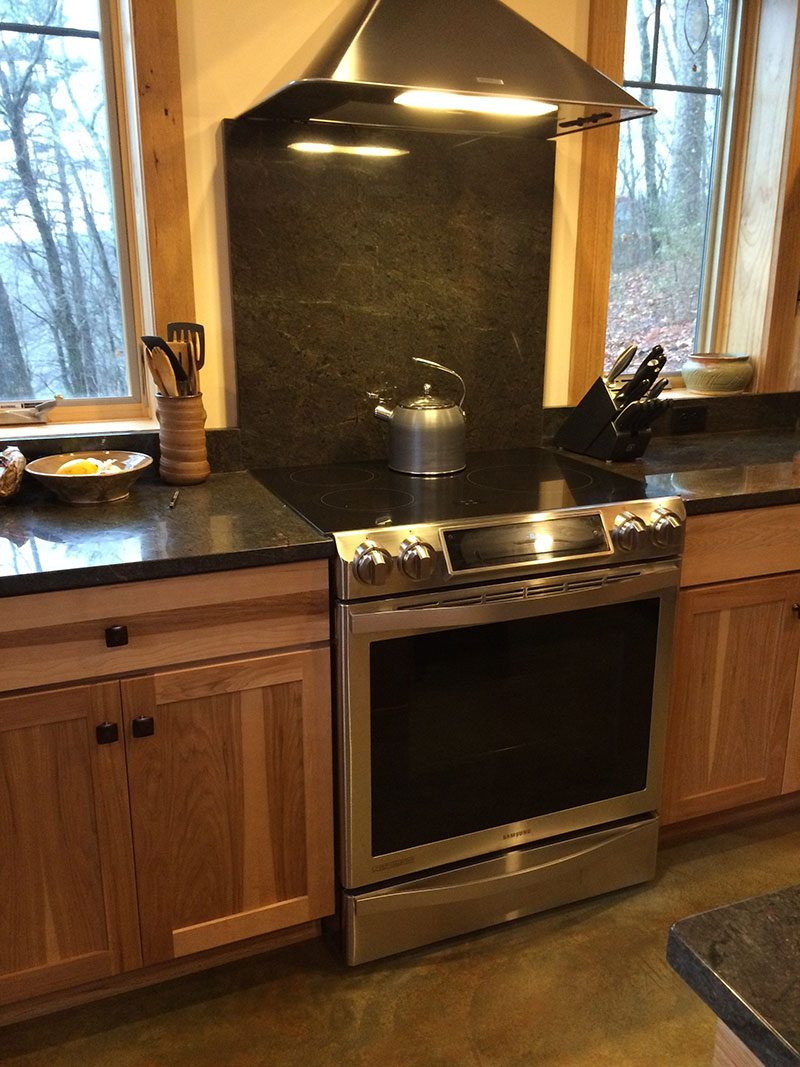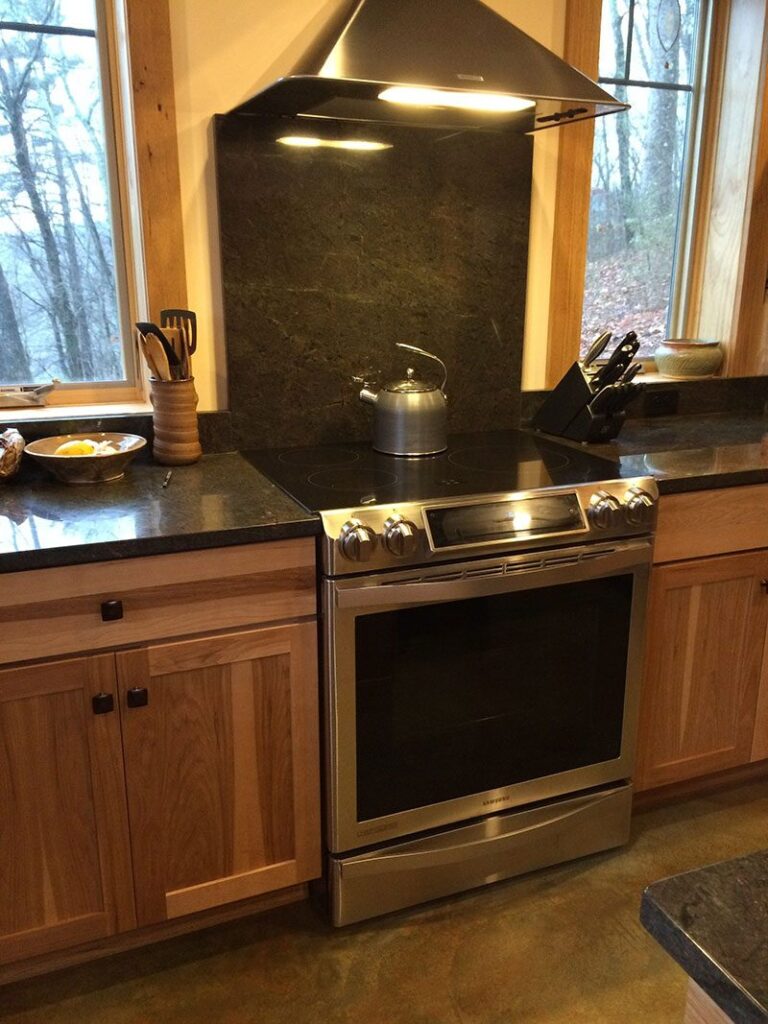Induction cooktops are new. I get a lot of questions about them, and at this point not enough designers, contractors, and homeowners are specifying them. In my opinion, they’re the best choice for just about everyone. In this week’s blog, I’d like to present my reasoning.
What makes induction cooktops better than other cooktops?
- They are the most controllable option. It took me about a week to learn exactly how mine works. A setting of 7 will boil water or soup without boiling it over, 4-5 will boil something thicker like a stew, and 3 will simmer a covered pot of rice. Unlike other electric stoves, the surface doesn’t get hot, so it responds instantly to changes in setting. You can bring rice to a boil on “high” and then you can turn it down to simmer on the same burner and get an instant response. Unlike gas, you don’t have to eyeball the flame and guess the setting to avoid boiling over.
- You’re less likely to hurt yourself on one. I love them for aging in place, for people with kids, and for people like me who do dumb things occasionally because they’re trying to listen to a podcast while cooking. Induction cooktops don’t get very hot (they do heat up a little because a hot pot of food is sitting on them – but it’s probably not enough to burn you) and if you don’t have a pot on the burner they will shut themselves off automatically. Other electric stoves work by getting so hot that they transfer heat through the bottom of the pan to cook your food. They stay hot for a long time when you’re done cooking so you have to be careful not to touch it or lay something plastic down on top of it. With gas, you actually have an open flame down there and you have to be careful to keep hair and loose clothing out of it.
- They’re the easiest to clean. Induction cooktops look like regular glasstops, with one crucial difference. Regular glasstops can be hard to clean when you boil food over and it bakes onto the top. Induction cooktops get a little warm because of the hot cookware on top of them, but not hot enough to bake anything on. And since you’re less likely to boil something over to begin with, there’s less to clean anyway. You can just wipe the surface down with a damp sponge as soon as you’re done cooking and it stays clean. No scrubbing or taking the burners apart and fishing out crumbs that fell down in there.
- You don’t need a gigantic kitchen range hood. A lot of the larger gourmet gas ranges require in their installation manuals that you install a very large range hood with it. Because the building code references the manufacturer’s installation manual, you by default need to install a giant (over 400 cfm) kitchen range hood. Oversized kitchen range hoods can cause all sorts of problems that you don’t want, but in a new house the first one you’ll encounter is that they require makeup air. The system to properly do this is probably going to add $1000-$2000 to your project, and there’s no ideal way to do it. Do yourself a favor and take this money and put it toward a nice induction cooktop.
- You don’t need to have gas or propane in your house. There are some valid energy efficiency reasons to use gas and propane, but in Western NC there are technologies that can allow you to achieve similar goals with electricity most of the time. If you’re building a near net-zero home, it doesn’t always make sense to pay service charges for two energy utilities – the service charges can become a significant portion of your energy expense. Electric technologies are also easier to directly offset with solar PV or to power from batteries. And again, you can take the cost of the gas piping and hookups and apply that to a really nice induction cooktop.
- There’s some evidence that induction cooktops offer superior indoor air quality performance. There are two main ways that cooking can negatively impact your indoor air quality: contaminants generated by the food itself cooking and contaminants introduced into the indoor air via the cooking equipment itself. Contaminants from the cooked food itself are largely independent of the cooking type, but the types of equipment behave differently. Other electric cooktops (burners and glass tops) can have burn-off of dust or spilled food that may smoke and generate contaminants. With gas, you have the flame itself that generates combustion by-products (including NOx and carbon monoxide, which have demonstrable health impacts). Because induction surfaces don’t get very hot, very little burn-off occurs, aside from the food.
- They’re more energy efficient. By heating just the pot, induction puts the heat exactly where you need it, using less energy and adding less heat to your home that could increase your air conditioning load.

Obviously, I think induction cooktops are a slam-dunk decision – better in every way than the other technologies that are out there. I’ve been using one for 4 years and I hate it when I travel and have to cook on anything else. Let’s explore some of the other reasons clients are hesitant about induction:
- It’s new and I don’t understand how it works, therefore I assume it’s bad for you. I know that induction seems like magic, but the scientific principle has been around for a long time. It’s used in motors, generators, transformers, and a lot of rechargeable home electronics items. You don’t have to understand how it works to use and love it, but the web site “how stuff works” has a great article if you want to learn about it. Can I personally 100% promise you that it doesn’t cause cancer in some weird way that we don’t know about yet? No. I’m not that kind of doctor and can’t promise you that about anything. But I do think that there are probably enough people out there with occupational exposures that if there were an obvious connection, we would know. But do you know what does have known health effects? Combustion byproducts. NOx, carbon monoxide, and particulate matter all have known health effects. This is an example of people being poor risk assessors. Because we’ve been cooking on flames for a long time, it doesn’t scare us. But that doesn’t mean it’s the healthiest choice. At the very least, if you’re going to make this argument and continue to cook on gas because you fear EMFs, you’d better make sure that you are religious about your use of the kitchen range hood whenever you cook on the stovetop AND operate your oven. Otherwise, you’re trading an unsubstantiated perceived health risk for a very well known one.
- I like cooking on gas. I don’t know anyone who has tried induction and not been won over. It does almost everything gas does, only better. A lot of professional chefs have converted. If you really like the primal experience of cooking on flames and you have disposable budget in your project, get a really nice outdoor gas grill setup.
- Induction cooktops are expensive. If you have an ultra-tight budget and have to go with a standard electric range because it’s the absolutely cheapest option, then this is valid. If you’re considering gas, I encourage you to really tally up the cost of the gas range, the larger kitchen hood, makeup air for the hood, and the gas piping before you assume that gas is cheaper. The range pictured is from the Samsung slide-in chef collection, and retails for about $3,000. It has four induction burners and a dual oven. This compares favorably to the cost of comparable gas ranges including piping, hookup, venting, and makeup air. If that’s out of your price range, there are less expensive glass-tops that have only one or two induction burners. We bought ours for about $1500.
- I want to be able to cook when the power is out. This one might be somewhat valid if the cooktop you’ve selected can be started without electricity. However, for as often as this happens to most people, the outdoor gas grill setup might work fine
Copyright 2016 Amy Musser.


